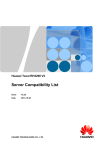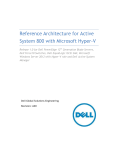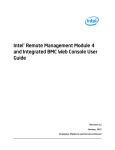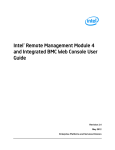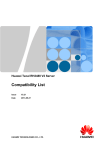Download Intel Xeon E5-2667 v2
Transcript
Intel® Xeon® Processor E5-2600 v2 Product Family PRODUCT BRIEF The Heart of a Modern Data Center Intel® Xeon® Processor E5-2600 v21 Product Family IT organizations around the world are driving higher value into their businesses by virtualizing their data centers and adding automation, so they can drive down costs and deliver new data-driven services more quickly and efficiently. Intel® Xeon® processor-based servers provide the foundation for this innovation. They account for the majority of all servers in today’s virtualized data centers and clouds, and also power many of today’s highest-performing workstations. Up to 35 Percent Higher Performance The Intel Xeon processor E5-2600 v2 product family provides 50 percent more cores and cache than the previous generation, along with faster memory and additional hardware enhancements for virtualization. These innovations deliver up to 35 percent higher performance on average over previous generation Intel Xeon processor-based servers across a broad range of benchmarks.+,2 Three key technologies offer particularly high value. • Higher performance for peak workloads. Intel® Turbo Boost Technology 2.03 automatically increases processor frequencies to take advantage of power and thermal headroom. This second-generation technology provides higher frequencies and greater intelligence so you enjoy faster performance and improved efficiency. • Up to 2x and higher performance gains for floating point operations.+,4 Intel® Advanced Vector Extensions (Intel® AVX) provides new instructions that can significantly improve+,5 performance for applications that rely on floating point or vector computations. The most recent enhancements speed 16/32-bit data conversions, which provide additional performance gains for select applications. • New virtualization efficiencies. Advanced Programmable Interrupt Controller virtualization (APICv) takes the value of Intel® Virtualization Technology (Intel® VT) to new heights. By eliminating up to 50 percent of virtual machine exits, it reduces virtualization overhead to 4 percent CPU utilization.+,6 to further improve performance and scalability. Eliminating Network Bottlenecks The Intel Xeon processor E5-2600 v2 product family provides exceptionally fast data movement in dense virtual environments to increase server performance and accelerate network and storage communications. • Intel® Integrated I/O for up to 2x higher bandwidth. PCI Express* 3.0 lanes are integrated directly onto the processor die—up to 80 lanes per two-socket server. This technology has been shown to reduce I/O latency by up to 30 percent,+,7 and provides up to twice the bandwidth versus solutions based on the PCIe 2.0 specification.+,8 Additional optimizations for storage and technical computing include new support for x16 Non-Transparent Bridging and improved P2P bandwidth. • Putting data right where you need it—fast. Intel® Data Direct I/O Technology enables direct data transfers from storage to cache. It increases I/O performance by up to 2.3 times+,9 and reduces memory access overheads. Strengthening Security and Compliance With the Intel Xeon processor E5-2600 v2 product family, you can protect your business more effectively using Intel® Security Technologies that help to improve workload isolation, security policy enforcement, and data encryption. • Better, faster data protection. Intel® Data Protection Technology10 includes Intel® Secure Key, which generates high-quality security keys, and Intel® Advanced Encryption Standard New Instructions (Intel® AES-NI), which provides hardware assists to accelerate and improve encryption. In combination with software from leading vendors, such as Oracle, Microsoft, and McAfee, these technologies provide the foundation for secure online transactions and enterprise-wide data protection—all without sacrificing application performance. • Hardened protection for virtual data centers and clouds. Establish trusted pools of virtual resources, so you can maintain security and compliance more effectively in dynamic, multi-tenant environments. Intel® Platform Protection Technology11 includes Intel® Trusted Execution Technology, which ensures that your systems and hypervisors boot only into cryptographically verified “known good states,” so they cannot be compromised during or prior to launch. It also includes OS Guard, which provides additional malware protection by preventing the execution of calls to the OS from compromised applications in the user mode or code pages. The Heart of a Modern Data Center Driving Down Energy Costs at Every Level Power and cooling costs continue to rise. The Intel Xeon processor E52600 v2 product family offers up to 40 percent more energy efficiency over previous generation Intel Xeon processor-based servers.+,12 It can help you get more value out of every watt by optimizing performance versus energy consumption, not only for individual servers, but also for racks, rows, and entire data centers. • Industry-leading energy efficiency per server. Intel’s 22nm, 3-D Tri-Gate transistors use just half the power+,13 of prior-generation transistors operating at the same performance level. Intel® Intelligent Power Technology14 adds to these gains by dynamically optimizing performance versus energy consumption across all operating points. • Automated control of server power. Intel® Node Manager lets you monitor and control server power and set maximum limits for each server. Use it to increase rack densities, adjust cooling based on actual demand, improve business continuity, and dynamically balance resources to accomplish more while spending less. • Power optimization across your data center. Intel® Data Center Manager plugs into existing management frameworks to enable power and thermal monitoring and management for individual servers and groups of servers. You gain unprecedented insight and control over power, cooling, and performance throughout your data center. Optimized Platform Solutions Intel delivers higher value by engineering complete, highly-optimized platform solutions. Higher performance for HPC applications+,5 • Intel® Advanced Vector Extensions (Intel® AVX) speeds vector and floating point computations, with support for 256-bit vectors and accelerated 32/64 bit data conversions • Provides up to 2x and higher performance boosts+,4 for floating point operations Improved virtualization efficiency • Advanced Programmable Interrupt Controller virtualization (APICv) enhances Intel Virtualization Technology by eliminating up to 50 percent of virtual machine exits • Reduces virtualization overhead to 4 percent of CPU utilization+,6 to improve performance and scalability Optimized Data Center Solutions to Reduce Costs Industry-leading I/O performance • Intel® Integrated I/O provides up to 80 PCIe* lanes per two-socket server, reduces latency by up to 30 percent,+,7 and supports the PCIe 3.0 specification for up to 2x+,8 higher I/O bandwidth. Support has been added for atomic operations and improved P2P bandwidth. • Intel® Data Direct I/O improves I/O performance up to 2.3x+,9 through direct storage-to-cache communications The first integrated storage/server processor • Supports key storage processor features, including x16 non-transparent bridging (vs. x8 NTB) to increase scalability and accelerated RAID for implementing RAID 5 and 6 without a custom ASIC • Use Intel® 10 Gigabit Ethernet to improve performance for demanding workloads and to consolidate your data center traffic onto a single, scalable, cloud-ready network. Stronger, faster data encryption • Add Intel® Cache Acceleration Software (Intel® CAS) and one or more Intel® Solid-State Drives (Intel® SSDs) per server to dramatically—and cost-effectively—boost storage performance. • AES-NI, which enables encryption to be implemented pervasively without sacrificing application response times • Combine Intel 10 Gigabit Ethernet and Intel SSDs with Intel® Distribution for Apache Hadoop* software to improve big data analytics performance by as much as 30x.+,15 Intel Platform Protection Technology with: Intel Data Protection Technology with: • Secure Key, which provides high-quality security keys A better foundation for secure multi-tenancy Intel® Xeon® Processor E5 v2 Product Family Overview • Intel Trusted Execution Technology, which enables IT to establish trusted pools of virtualized resources for stronger security and compliance in multi-tenant virtual and cloud environments High Performance for the Broadest Range of Applications and Environments • OS Guard, which protects against escalation of privilege attacks that attempt to gain control of the platform or execute malware Advanced multi-core, multi-threaded processing • Up to 12 cores and 24 threads per socket Industry-leading energy-efficiency • Intel 22 nm, 3-D tri-gate transistors cut power consumption by half versus the prior generation+,13 • Higher density and better performance for virtualized data centers and public/private clouds Larger cache and faster memory • Up to 30 MB of last level cache for fast access to frequently used data • Up to 24 DIMMs per two-socket server to support multiple data-hungry VMs • Faster maximum memory speeds than the previous generation (1866 MHz versus 1600 MHz) • Intel® Intelligent Power Technology14 dynamically manages CPU and memory energy states to minimize power without slowing performance Comprehensive monitoring and control • Intel® Node Manager lets IT monitor and control server power • Intel® Data Center Manager lets IT dynamically optimize energyconsumption at every level, from individual servers, racks, and rows to entire data centers Higher performance for peak workloads • Intel Turbo Boost Technology 2.03 takes advantage of power and thermal headroom to increase processor frequencies for peak workloads 2 The Heart of a Modern Data Center CPU FREQUENCY INTEL® TURBO BOOST TECHNOLOGY3 INTEL® HT TECHNOLOGY L3 CACHE NUMBER OF CORES POWER INTEL® QPI LINK SPEED DDR3 MEMORY Table 2. Intel® Xeon® Processor E5 v2 Family Specifications Intel® Xeon® Processor E5-2697 v2 2.7 GHz 2.0 • 30 MB 12 130 W 8.0 GT/s 1866 Intel® Xeon® Processor E5-2695 v2 2.4 GHz 2.0 • 30 MB 12 115 W 8.0 GT/s 1866 Intel® Xeon® Processor E5-2690 v2 3.0 GHz 2.0 • 25 MB 10 130 W 8.0 GT/s 1866 Intel® Xeon® Processor E5-2680 v2 2.8 GHz 2.0 • 25 MB 10 115 W 8.0 GT/s 1866 Intel® Xeon® Processor E5-2670 v2 2.5 GHz 2.0 • 25 MB 10 115 W 8.0 GT/s 1866 Processor Number For 2-Socket Servers – Advance Intel® Xeon® Processor E5-2667 v2 3.3 GHz 2.0 • 25 MB 8 130 W 8.0 GT/s 1866 Intel® Xeon® Processor E5-2660 v2 2.2 GHz 2.0 • 25 MB 10 95 W 8.0 GT/s 1866 Intel® Xeon® Processor E5-2650 v2 2.6 GHz 2.0 • 20 MB 8 95 W 8.0 GT/s 1866 Intel® Xeon® Processor E5-2650L v2 1.7 GHz 2.0 • 25 MB 10 70 W 8.0 GT/s 1600 Intel® Xeon® Processor E5-2643 v2 3.5 GHz 2.0 • 25 MB 6 130 W 8.0 GT/s 1866 Intel® Xeon® Processor E5-2637 v2 3.5 GHz 2.0 • 15 MB 4 130 W 8.0 GT/s 1866 Intel® Xeon® Processor E5-2640 v2 2.0 GHz 2.0 • 20 MB 8 95 W 7.2 GT/s 1600 Intel® Xeon® Processor E5-2630 v2 2.6 GHz 2.0 • 15 MB 6 80 W 7.2 GT/s 1600 Intel® Xeon® Processor E5-2630L v2 2.4 GHz 2.0 • 15 MB 6 60 W 7.2 GT/s 1600 Intel® Xeon® Processor E5-2620 v2 2.1 GHz 2.0 • 15 MB 6 80 W 7.2 GT/s 1600 Intel® Xeon® Processor E5-2609 v2 2.5 GHz – – 10 MB 4 80 W 6.4 GT/s 1333 Intel® Xeon® Processor E5-2603 v2 1.8 GHz – – 10 MB 4 80 W 6.4 GT/s 1333 3.4 GHz 2.0 • 25 MB 8 150 W 8.0 GT/s 1866 For 2-Socket Servers – Standard For 2-Socket Servers – Basic For 2-Socket Workstations Intel® Xeon® Processor E5-2687W v2 For 1-Socket Workstations Intel® Xeon® Processor E5-1660 v2 3.7 GHz 2.0 • 15 MB 6 130 W N/A 1866 Intel® Xeon® Processor E5-1650 v2 3.5 GHz 2.0 • 12 MB 6 130 W N/A 1866 Intel® Xeon® Processor E5-1620 v2 3.7 GHz 2.0 • 10 MB 4 130 W N/A 1866 To learn more about the Intel® Xeon® processor E5-2600 v2 product family, visit www.intel.com/products/server/processor/xeonE5/index.htm 3 The Heart of a Modern Data Center Software and workloads used in performance tests may have been optimized for performance only on Intel microprocessors. Performance tests, such as SYSmark and MobileMark, are measured using specific computer systems, components, software, operations and functions. Any change to any of those factors may cause the results to vary. You should consult other information and performance tests to assist you in fully evaluating your contemplated purchases, including the performance of that product when combined with other products. 1 Intel processor numbers are not a measure of performance. Processor numbers differentiate features within each processor family, not across different processor families. See www.intel.com/products/ processor_number for details. 2 Source for “up to 35% performance increase”: SPECint*_rate_base2006: Baseline Configuration and Score on Benchmark: Cisco UCS C220 M3 using two Intel® Xeon® processor E5-2690 (2.9 GHz, 8-core , 20 MB L3 cache, 8.0 GT/s, 135W), 128GB memory (16x 8 GB 2Rx4 PC3-12800R-11, ECC), 300 GB SAS 15 K RPM, Red Hat* Enterprise Linux Server 6.2 with kernel 2.6.32-220.el6.x86_64. Compiler version: C/C++: Version 13.0.0.133 of Intel C++ Studio XE for Linux. Source: http://www.spec.org/cpu2006/results/res2013q2/cpu2006-20130319-25591.html as of Feb 2013. Score: 681. New Configuration and Score on Benchmark: Intel® Server Board S2600CP platform with two Intel® Xeon® Processor E5-2697 v2 (2.7 GHz, 12-core, 30 MB L3 cache, 8.0 GT/s, 130W, C0-stepping) , EIST Enabled, Turbo Boost enabled, Hyper-Threading Enabled, 128 GB memory (8x16 GB DDR3-1866), Red Hat* Enterprise Linux Server 6.3. CPU2006-1.2 with Intel compiler IC13.1 Source Intel TR#1270 as of 11 June 2013. Estimated Score: 906. SPECfp*_rate_base2006: Baseline Configuration and Score on Benchmark: Huawei RH2288 V2 using two Intel® Xeon® processor E5-2690 (2.9 GHz, 8-core, 20 MB L3 cache, 8.0 GT/s, 135W), 128GB memory (16x 8GB 2Rx4 PC3-12800R-11, ECC), 300 GB SAS 10 K RPM, Red Hat* Enterprise Linux Server 6.2 with kernel 2.6.32-220.el6.x86_64. Compiler version: C/C++: Version 13.0.0.079 of Intel C++ Studio XE for Linux; Fortran: Version 13.0.0.079 of Intel Fortran Studio XE for Linux. Source: http://www.spec.org/cpu2006/results/res2013q1/cpu2006-20121211-25284.html as of Dec 2012. Score: 503. New Configuration and Score on Benchmark: Intel® Server Board S2600CP platform with two Intel® Xeon® Processor E5-2697 v2 (2.7GHz, 12-core, 30MB L3 cache, 8.0GT/s, 130W, C0-stepping) , EIST Enabled, Turbo Boost enabled, Hyper-Threading Enabled, 128GB memory (8x16GB DDR3-1866), Red Hat* Enterprise Linux Server 6.3. CPU2006-1.2 with Intel compiler IC13.1 Source Intel TR#1270 as of 11 June 2013. Estimated Score: 638. Server Virtualization Benchmark: Baseline Configuration and Score on Benchmark: Intel® Server Board S2600GL platform with two Intel® Xeon® Processor E5-2690 (2.9 GHz, 8-core, 20MB L3 cache, 8.0GT/s, 135W, C2-stepping), Virtualization Technology Enabled, Turbo Enabled, HT Enabled, NUMA Enabled, MLC Spatial Prefetcher Enabled, DCU Data Line Prefetcher Enabled, 256GB memory (16x 16 GB DDR3-1333 DR REG ECC), 128GB SATA SSD, ESXi4.1u1 (build 348481). Source: Intel TR#1359 as of 24 July 2013. Score: 1723 @ 108VMs. New Configuration and Score on Benchmark: Intel® Server Board S2600CP platform with two Intel® Xeon® Processor E5-2697 v2 (2.7 GHz, 12-core, 30 MB L3 cache, 8.0 GT/s, 130W, C0-stepping), Virtualization Technology Enabled, Turbo Enabled, HT Enabled, NUMA Enabled, MLC Spatial Prefetcher Enabled, DCU Data Line Prefetcher Enabled, 256 GB memory (16x 16 GB DDR3-1866 DR REG ECC), 128 GB SATA SSD, ESXi 5.1(build 799733). Source: Intel TR#1359 as of 24 July 2013. Score: 2246 @ 144VMs Enterprise Resource Planning Benchmark: Baseline Configuration and Score on Benchmark: Intel® Server Board S2600CP platform with two Intel® Xeon® Processor E5-2690 (2.9 GHz, 8-core, 20 MB L3 cache, 8.0 GT/s, 135W, C2-stepping), Turbo Enabled, HT Enabled, NUMA Enabled, MLC Spatial Prefetcher Enabled, DCU Data Line Prefetcher Enabled, 128 GB memory, SLES11-SP1, Oracle Database 10.2.0.4, Application SAP ECC6.0 EHP4. Source: Intel TR#1706 as of 18 July 2013.Score: 6,847. New Configuration and Score on Benchmark: Intel® Server Board S2600CP platform with two Intel® Xeon® Processor E5-2697 v2 (2.7 GHz, 12-core, 30 MB L3 cache, 8.0 GT/s, 130W, C0-stepping), Turbo Enabled, HT Enabled, NUMA Enabled, MLC Spatial Prefetcher Enabled, DCU Data Line Prefetcher Enabled, 128 GB memory (16x8 GB DDR3-1600), SLES11-SP1-GM, Oracle Database 10.2.0.4, Application SAP ECC6.0 EHP4. Source: Intel TR#1706 as of 18 July 2013. Score: 9,444. Server-side Java* Benchmark: Baseline Configuration and Score on Benchmark: Intel® Server Board S2600CP platform with two Intel® Xeon® Processor E5-2690 (2.9 GHz, 8-core, 20 MB L3 cache, 8.0 GT/s, 135W, C2-stepping), 128GB memory (16x8GB DDR3-1600), RHEL 6.2.32, Oracle Hotspot 1.7.0_21-b05. Source: Intel TR#1310 as of 18 July 2013. Score: 40,047 max-jOPs. New Configuration and Score on Benchmark: Intel® Server Board S2600CP platform with two Intel® Xeon® Processor E5-2697 v2 (2.7GHz, 12-core, 30MB L3 cache, 8.0GT/s, 130W, C0-stepping), 64 GB memory (8x8 GB DDR3-1866), RHEL 6.2.32, Oracle Hotspot 1.7.0_40-ea-b2. Source: Intel TR#1310 as of18 July 2013. Score: 58,279 max-jOPs. 3 Requires a system with Intel® Turbo Boost Technology. Intel Turbo Boost Technology and Intel Turbo Boost Technology 2.0 are only available on select Intel® processors. Consult your PC manufacturer. Performance varies depending on hardware, software, and system configuration. For more information, visit http://www.intel.com/go/turbo 4 Performance comparison using Linpack benchmark. Baseline score of 159.4 based on Intel internal measurements as of 5 December 2011 using a Supermicro* X8DTN+ system with two Intel® Xeon® processor X5690, Turbo Enabled, EIST Enabled, Hyper-Threading Enabled, 48 GB RAM, Red Hat* Enterprise Linux Server 6.1 beta for x86_6. New score of 347.7 based on Intel internal measurements using an Intel® Rose City platform with two Intel® Xeon® processor E5-2690, Turbo Enabled or Disabled, EIST Enabled, Hyper-Threading Enabled, 64 GB RAM, Red Hat* Enterprise Linux Server 6.1 beta for x86_6. 5 AVX is designed to achieve higher throughput to certain integer and floating point operations. Depending on processor power and thermal characteristics and system power and thermal conditions, AVX floating point instructions may run at lower frequency to maintain reliable operations at all times. 6 Configuration : Pre-Production 1S Intel® Xeon® Processor E5-2600 (3.0 GHz, 4-core, 10 MB L3 cache, B0-stepping), HyperThreading ON, Turbo OFF, EIST OFF, CPU C-state OFF, Power feature OFF, Virtualization Technology ON, NUMA ON, Prefetch OFF, 64GB SSD, Xen-unstable C/S23237 w/ APIC-v patch. Hypervisor CPU utilization with no APICv: 5.5%; Hypervisor CPU utilization with APICv: 4%. Source: Intel internal measurements as of December 2011. 7 Source: Intel internal measurements of average time for an I/O device read to local system memory under idle conditions comparing Intel® Xeon® processor E5-2600 product family (230 ns) vs. Intel® Xeon® processor 5500 series (340 ns). Baseline Configuration: Green City system with two Intel® Xeon processor E5520 (2.26 GHz, 4C), 12 GB memory @ 1333, C-States Disabled, Turbo Disabled, SMT Disabled, Rubicon* PCIe* 2.0 x8. New Configuration: Meridian system with two Intel® Xeon processor E5-2665 (C0 stepping, 2.4 GHz, 8C), 32 GB memory @1600 MHz, C-States Enabled, Turbo Enabled. The measurements were taken with a LeCroy* PCIe*protocol analyzer using Intel internal Rubicon (PCIe* 2.0) and Florin (PCIe* 3.0) test cards running under Windows* 2008 R2 w/SP1. 8 8 GT/s and 128b/130b encoding in PCIe 3.0 specification enables double the interconnect bandwidth over the PCIe* 2.0 specification. Source: http://www.pcisig.com/news_room/November_18_2010_Press_Release/ 9 Source: The claim of up to 2.3x I/O performance is based on Intel internal measurements comparing 1-socket SNB data for an L2 forwarding test using 8x10 GbE ports for the Intel® Xeon® processor E5 product family versus the Intel® Xeon® processor 5600 series. 10 No computer system can provide absolute security. Requires an enabled Intel® processor and software optimized for use of the technology. Consult your system manufacturer and/or software vendor for more information. 11 No computer system can provide absolute security. Requires an enabled Intel® processor, enabled chipset, firmware, software, may require a subscription with a capable service provider (may not be available in all countries). Intel assumes no liability for lost or stolen data and/or systems or any other damages resulting thereof. Consult your Service Provider for availability and functionality. For more information, visit http:// www.intel.com/go/anti-theft. Consult your system manufacturer and/or software vendor for more information. 12 Baseline Configuration and Score on Server-Side Java* Energy Efficiency benchmark: Intel® Server Board S2600CP platform with two Intel® Xeon® Processor E5-2690 (2.9 GHz, 8-core, 20 MB L3 cache, 8.0 GT/s, 135W), Hardware Prefetcher: Disabled; MLC Spatial Prefetcher: Disabled, DCU Streamer: Disabled; DCU IP: Enabled; Balanced Perf Mode, 32 GB memory (8 x 4 GB DDR3L-1600 ECC REG), Microsoft* Windows Server 2008 R2 SP1, IBM J9 VM 1.7.0. Score: 4,033. Source: Intel TR#1299 as of 12 Aug 2013. New Configuration and Score on Server-Side Java* Energy Efficiency benchmark: Intel® Server Board S2600CP platform with two Intel® Xeon® Processor E5-2697 v2 (2.7 GHz, 12-core, 30 MB L3 cache, 8.0 GT/s, 130W, C0-stepping), Hardware Prefetcher: Disabled; MLC Spatial Prefetcher: Disabled, DCU Streamer: Disabled; DCU IP: Enabled; Hyper-threading: Enabled; Turbo: Enabled; Balanced Perf Mode, 32GB memory (8 x 4GB DDR3L-1600 ECC REG), Microsoft* Windows Server 2008 R2 SP1, IBM J9 VM 1.7.0. Score : 5,670. Source: Intel TR#1299 as of 12 Aug 2013. 13 Compared to previous generation 2-D transistors on 32nm planar transitors. Source: Intel internal testing 14 Intel® Intelligent Power Technology requires a computer system with an enabled Intel® processor, chipset, BIOS and for some features, an operating system enabled for it. Functionality or other benefits may vary depending on hardware implementation and may require a BIOS and/or operating system update. Please check with your system vendor for details. 15 Source: TeraSort Benchmarks conducted by Intel in December 2012. Custom settings: mapred.reduce.tasks=100 and mapred.job.reuse.jvm.num.tasks=-1. Cluster configuration: One head node (name node, job tracker), 10 workers (data nodes, task trackers), Cisco Nexus* 5020 10 Gigabit switch. Performance measured using Iometer* with Queue Depth 32. Baseline worker node: SuperMicro SYS-1026T-URF 1U servers with two Intel® Xeon® processors X5690 @ 3.47 GHz, 48 GB RAM, 700 GB 7200 RPM SATA hard drives, Intel® Ethernet Server Adapter I350-T2, Apache Hadoop* 1.0.3, Red Hat Enterprise Linux* 6.3, Oracle Java* 1.7.0_05. Baseline storage: 700 GB 7200 RPM SATA hard drives, upgraded storage: Intel® Solid-State Drive 520 Series (the Intel® Solid-State Drive 520 Series is currently not validated for data center usage). Baseline network adapter: Intel® Ethernet Server Adapter I350-T2, upgraded network adapter: Intel® Ethernet Converged Network Adapter X520-DA2.Upgraded software in worker node: Intel® Distribution for Apache Hadoop* software 2.1.1. Note: Solid-state drive performance varies by capacity. More information: http://hadoop.apache.org/docs/current/api/org/apache/hadoop/examples/terasort/package-summary.html Performance and competitive information is accurate at time of document publication. For latest competitive and performance information, visit www.intel.com/performance. Performance tests and ratings are measured using specific computer systems and/or components and reflect the approximate performance of Intel products as measured by those tests. Any difference in system hardware or software design or configuration may affect actual performance. Buyers should consult other sources of information to evaluate the performance of systems or components they are considering purchasing. For more information on performance tests and on the performance of Intel products, visit www.intel.com/performance/resources/limits.htm or call (U.S.) 1-800-628-8686 or 1-916-356-3104. All dates and products specified are for planning purposes only and are subject to change without notice. Relative performance for each benchmark is calculated by taking the actual benchmark result for the first platform tested and assigning it a value of 1.0 as a baseline. Relative performance for the remaining platforms tested was calculated by dividing the actual benchmark result for the baseline platform into each of the specific benchmark results of each of the other platforms and assigning them a relative performance number that correlates with the performance improvements reported. Information in this document is provided in connection with Intel products. No license, express or implied, by estoppel or otherwise, to any intellectual property rights is granted by this document. Except as provided in Intel’s Terms and Conditions of Sale for such products, Intel assumes no liability whatsoever, and Intel disclaims any express or implied warranty, relating to sale and/or use of Intel products including liability or warranties relating to fitness for a particular purpose, merchantability, or infringement of any patent, copyright or other intellectual property right. Intel products are not intended for use in medical, life saving, or life sustaining applications. Intel may make changes to specifications and product descriptions at any time, without notice. + Copyright © 2013 Intel Corporation. All rights reserved. Intel, the Intel logo, Look Inside, the Look Inside logo, Xeon, and Xeon Inside are trademarks of Intel Corporation in the U.S. and other countries. * Other names and brands may be claimed as the property of others. Printed in USA 0813/KW/HBD/PDF 326036-001US





